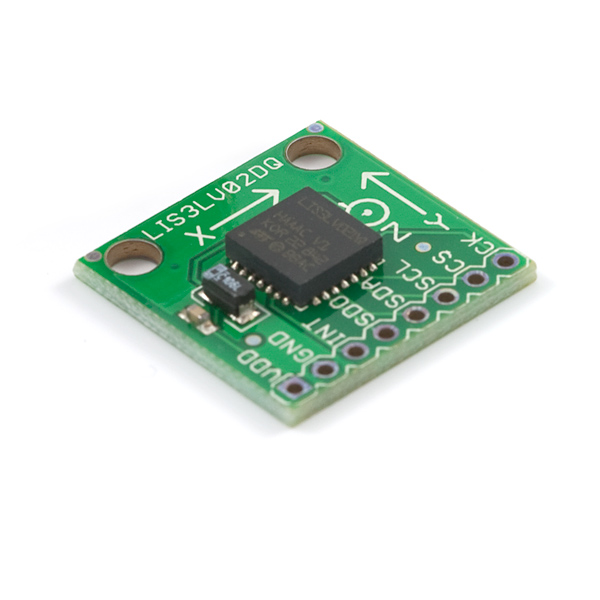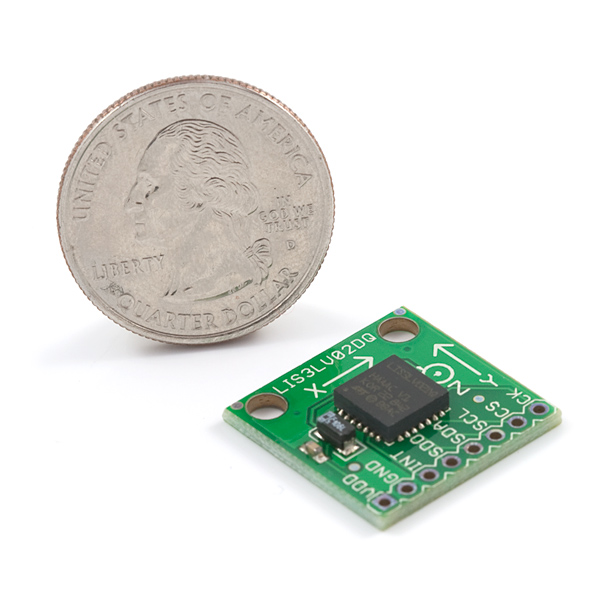Triple Axis Accelerometer Breakout - LIS3LV02DQ
Replacement:SEN-09836. This is not a direct replacement but is applicable in most cases. This page is for reference only.
Breakout board for the 3 axis LIS3LV02DQ accelerometer from ST Micro. Please view the datasheet for this impressive sensor! With a digital interface (SPI or I2C), the user only has to initiate commands to get 1mg resolution! Independent channels can be shut off, the sensor can be powered down, even an interrupt threshold can be set and used to awaken the sensor from power down! Selectable ranges are available for +/-2g and 6g. This sensor is one of the first with triple axis and an easy to use digital interface. Board comes fully assembled and tested with external decoupling caps.
We were thoroughly impressed with the flexibility and precision of this sensor. This is a great sensor to play with if you need triple axis accelerations in digital form and you don't want to deal with analog conversions or filtering.
Interface: The LIS3LV02DQ is a 3.3V part and outputs SPI or I2C digital. This can be interfaced to any micro with or without built-in SPI or I2C support. Fake it in firmware! See example code.
- 21x23mm (0.8x0.9")
- LIS3LV02DQ Breakout Schematic
- Example SPI firmware for PIC 16F88
- Example Arduino interface by Troy Nachtigall
Comments
Looking for answers to technical questions?
We welcome your comments and suggestions below. However, if you are looking for solutions to technical questions please see our Technical Assistance page.
Customer Reviews
No reviews yet.





Nice and easy to handle sensor. the price is maybe a bit high for the breakout.
Not a 5V part. Ran on 5V and it worked for a few hours. The Y axis accel eventually developed significant offset until it was unusable. Then, halfway through a flight, the X axis developed significant offset. At 3.3V it probably is more reliable, but PIC\\'s are less reliable at 3.3V, and you end up with a lot of electronics to convert voltages.
Also the filtering on this is suspect. In high vibration it seems to quantize way beyond the desired resolution. Might be better off with a bare analog sensor and averaging.
The datasheet does clearly state that it's operating voltage range is 2.16V to 3.6V?
What makes you think a PIC is less reliable at 3.3V than at 5V?
Hi every one!
I want to use this sensor with sample project but I'm a beginner!
Now I want to know how can I compile the sample code(by which compiler software?)I test it by PICbasic pro but it doesn't work.
and is there any schematic that show to me communication between PIC16f88 and LIS3LV02DQ?
bengineerd : The breakout board is cheap when you compare it to the socket alone that I can't find anywhere for less than $50
i would like that somebody can help me, i dont understand why my LIS3LV02DQ, is working SO SO, i can get the data for axis x and axis Y perfectly, but no change de axis Z Data, always show the same value, is possible that my LIS3LVO2DW is damage just this Z axis(only bad axis Z).
If the standalone chip is available for $15.95, why is the breakout board so (relatively) expensive at $43.95. The other breakout boards don't seem to have such a high markup over the chip price.